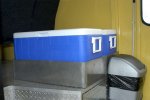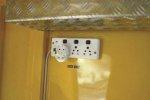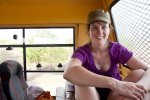You are using an out of date browser. It may not display this or other websites correctly.
You should upgrade or use an alternative browser.
You should upgrade or use an alternative browser.
TerraLiner:12 m Globally Mobile Beach House/Class-A Crossover w 6x6 Hybrid Drivetrain
- Thread starter biotect
- Start date
biotect
Designer
CONTINUED FROM PREVIOUS POST
**************************************************
- Drifters Adventures
Now if the windows on the Acacia African Overland trucks seemed large, then comparatively speaking, the windows on Drifters Adventures trucks are positively gigantic, even though the overall truck size (13 tons) is smaller. See http://driftersadventures.com , http://driftersadventures.com/images/DRIFTERS-FLYER-2014-w.pdf , http://www.comparesafaris.com/drifters.html , and http://www.drifters.co.za :





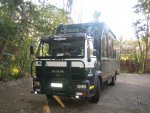
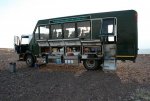
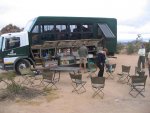
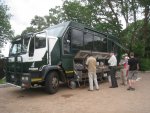
**************************************************
CONTINUED IN NEXT POST
.
Last edited:
biotect
Designer
..
CONTINUED FROM PREVIOUS POST
**************************************************

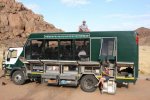

[video=youtube;rrxdHlgnZ5s]https://www.youtube.com/watch?v=rrxdHlgnZ5s [/video]
So thjakits, I am really curious how you will explain all of this. You have taken a very strong stand against large, abundant windows, and against unprotected windows. The last three pages of images seem to suggest that exactly the opposite is perfectly possible, in overlanding vehicles designed to handle some very rough roads.
Any thoughts?
Or, if anyone else can explain the contradiction between the "received wisdom" about expedition motorhome windows (windows best kept small, and completely covered when underway), versus these images of abundantly windowed commercial overlanding vehicles, please do.
Here are some images of the expedition vehicle built by Paradise Motorhomes, with its windows well-covered when underway, as per the Wothahellizat:

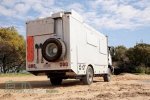

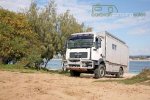
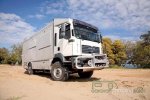
optimusprime already pointed out that commercial overlanding trucks have to be built with large windows, otherwise their clients would not be getting their money's worth:
In other words, commercial overlanding trucks have no choice but to resemble buses that provide lots of outside visibility.
But what then interests me is that commercial overlanding trucks can be so abundantly windowed. If the "received wisdom" about expedition motorhome windows were true, then these commercial overlanding trucks should be technically impossible. According to the "received wisdom" this is not a matter of mere personal taste, but rather, it's a matter of technical necessity: windows have to be small, and they have to be covered when underway. But if this were indeed true, then commercial overlanding trucks should be shattering at least one window every 200 km, because they have so many windows, and their windows are so large.
All best wishes, and Merry Christmas!
Biotect
CONTINUED FROM PREVIOUS POST
**************************************************



[video=youtube;rrxdHlgnZ5s]https://www.youtube.com/watch?v=rrxdHlgnZ5s [/video]
So thjakits, I am really curious how you will explain all of this. You have taken a very strong stand against large, abundant windows, and against unprotected windows. The last three pages of images seem to suggest that exactly the opposite is perfectly possible, in overlanding vehicles designed to handle some very rough roads.
Any thoughts?
Or, if anyone else can explain the contradiction between the "received wisdom" about expedition motorhome windows (windows best kept small, and completely covered when underway), versus these images of abundantly windowed commercial overlanding vehicles, please do.
Here are some images of the expedition vehicle built by Paradise Motorhomes, with its windows well-covered when underway, as per the Wothahellizat:





optimusprime already pointed out that commercial overlanding trucks have to be built with large windows, otherwise their clients would not be getting their money's worth:
Thats your answer right there, 'Commercially operated'.
Think about it, you have people, probably like me, who have to work and save up hard for a trip like the one above.
You'd be pretty hacked off if you spent most of the journey sat the the seat without a window!
At the end of the day, they are a buisiness, and there will be a schedule they have to keep up with ( no matter how accomodating they are) they won't have the luxury of the 'expeditioner' who can more or less do as they please.
That is not to say lots of windows are a bad thing, but you need to seperate the needs of 'commercial' and 'private'.
Personally the lots of glass v the least amount of glass arguement is very personal.
In other words, commercial overlanding trucks have no choice but to resemble buses that provide lots of outside visibility.
But what then interests me is that commercial overlanding trucks can be so abundantly windowed. If the "received wisdom" about expedition motorhome windows were true, then these commercial overlanding trucks should be technically impossible. According to the "received wisdom" this is not a matter of mere personal taste, but rather, it's a matter of technical necessity: windows have to be small, and they have to be covered when underway. But if this were indeed true, then commercial overlanding trucks should be shattering at least one window every 200 km, because they have so many windows, and their windows are so large.
All best wishes, and Merry Christmas!
Biotect
Last edited:
Haf-E
Expedition Leader
I think that the comparison of the expo bus type vehicles with a expo camper is not accurate - I always viewed the fold down window shutters as being more for security when parked and for shading when opened.
An expo bus probably has a well paid employee staying with the vehicle all of the time - so security while parked isn't as much of an issue. I don't know anybody who overland travels who brings along a security person for their vehicle.
The other point is that with the expo bus type vehicles - they are not living / sleeping in the vehicle probably. Its easy to feel like a fish in a bowl with a lot of windows all round - and it takes away from storage areas. Look at the classic westfalia VW bus conversions - they block out the last back window to provide storage space. I've seen a couple of other converted passenger vans which had blanked out windows to improve security and storage.
Also - they probably carry a spare window pane or two with them in case a window is broken - or have them stashed with spare parts along the route they travel. The truck themselves are probably a model which is supported in the countries they visit - so replacing the windshield is an option since it is a stock size.
I agree with the idea of lots of windows for the passenger areas - and for part of the living quarters - but I think the shutters over some windows is a nice feature.
An expo bus probably has a well paid employee staying with the vehicle all of the time - so security while parked isn't as much of an issue. I don't know anybody who overland travels who brings along a security person for their vehicle.
The other point is that with the expo bus type vehicles - they are not living / sleeping in the vehicle probably. Its easy to feel like a fish in a bowl with a lot of windows all round - and it takes away from storage areas. Look at the classic westfalia VW bus conversions - they block out the last back window to provide storage space. I've seen a couple of other converted passenger vans which had blanked out windows to improve security and storage.
Also - they probably carry a spare window pane or two with them in case a window is broken - or have them stashed with spare parts along the route they travel. The truck themselves are probably a model which is supported in the countries they visit - so replacing the windshield is an option since it is a stock size.
I agree with the idea of lots of windows for the passenger areas - and for part of the living quarters - but I think the shutters over some windows is a nice feature.
biotect
Designer
Hi Haf-E,
All of your points are very well taken. But saying that window shutters are for security, is different than saying they are technically necessary to protect the windows from rocks. Or saying that side windows are best kept small because of flying rocks. And agreed, even VW Kombi conversions can't have windows all around, because they need to block out some of them for storage.
Was gladdened to read your final sentence:
All best wishes,
Biotect
All of your points are very well taken. But saying that window shutters are for security, is different than saying they are technically necessary to protect the windows from rocks. Or saying that side windows are best kept small because of flying rocks. And agreed, even VW Kombi conversions can't have windows all around, because they need to block out some of them for storage.
Was gladdened to read your final sentence:
That's exactly what I have been designing.....:coffeedrink:I agree with the idea of lots of windows for the passenger areas - and for part of the living quarters - but I think the shutters over some windows is a nice feature.
All best wishes,
Biotect
DiploStrat
Expedition Leader
.
So thjakits, I am really curious how you will explain all of this. You have taken a very strong stand against large, abundant windows, and against unprotected windows. The last three pages of images seem to suggest that exactly the opposite is perfectly possible, in overlanding vehicles designed to handle some very rough roads.
Any thoughts?
Or, if anyone else can explain the contradiction between the "received wisdom" about expedition motorhome windows (windows best kept small, and completely covered when underway), versus these images of abundantly windowed commercial overlanding vehicles, please do.
As I have years of experience with West Africa and have several times run into Encounter Overland, Rotel, SIAFU, and any number of other groups, I'll take a swing at this.

(Siafu overland, Kano, Nigeria 1974. They had been broken down for weeks in the Sahara - not happy campers!)
First of all, these are busses, not campers; entirely different animals. A bus is much simpler to execute for rough roads as there isn't that much inside that can be damaged by vibration or torsion. Contrast this with the typical camper where the interior is divided into rooms, counters, cabinets, etc. (Of course, as this is all a blue sky project, you could postulate the those interior partitions could be load bearing, reinforcing a honeycomb/ monocoque structure, which is exactly what I would do.)
Secondly, all of these beasts are primarily designed for warmer weather or are simply kept warm through virtually unlimited excess heat from the engine. They are NOT heated at night. Thus heat loss through those windows is not a big issue. Similarly, many of them are not air conditioned, so air flow may be very important. While these groups definitely do the Andes, etc., you will note that most of the "happy camper" pictures are taken on sunny days and NOT in the rainy season or in the snow and none show clouds of mosquitos.
Next, many of these groups simply use tents for sleeping accommodations. Rotel used to have the most interesting arrangement, little coffin like beds in a form of pullman trailer. (Sometimes executed as bus/pullman combo.)
Finally, all of these systems work on an abundance of labor. That is, the guests, generally more that a dozen young males, are responsible for setting up and breaking camp - very different from the classic definition of an overland camper van as defined as a vehicle run by a couple; one male, one female. (To paraphrase Stephen Stewart - who gave up on the whole Unimog mess and now drives a commercially built Bimobil.)
My vehicle, Ndeke Luka, http://diplostrat.org/about/ has R10 insulation on all sides and Seitz double pane windows. Even with excellent cabin heat, we can get frost on the inside of the windows in the coldest part of the camper. Thus I would argue that, at least with commercially available options, windows will represent an area of heat loss.
N.B. In the old days, Rotel used to use a most interesting formula:
-- Standard Mercedes Benz bus to carry the passengers.
-- Pullman sleeper, towed by the bus.
-- MAN 6x6 tech support vehicle with winch, tools, supplies, etc. to get the bus through the rough spots.
http://www.rotel.de
Video of a 1969 Rotel Sahara trip:
Last edited:
dwh
Tail-End Charlie
In an overland bus, you have people in the rear cabin while the vehicle is underway. So in the bus, they *must* have those windows - not unlike a passenger car in a train.
But that's a compromise.
Drawbacks to the large glass area:
* It can get damaged.
* Not great insulation.
* Can turn the living space into a greenhouse/sweatbox/icebox, which then increases heating and cooling system requirements.
* Can turn the occupants into, as Haf-E just said, "fish in a bowl".
* Security vulnerability.
For a bus, you have to compromise and accept the drawbacks. Not so for a campervan.
In an overland campervan designed to accommodate a couple on a long term journey, both people will probably be in the front while underway (most of the time anyway).
All that glass might be nice to have when parked (though large screened hatches might be even nicer - especially parked on a beach), they aren't needed while underway and are certainly a security issue while shipping (and your truck will be too big to fit in a container).
In real world use, I would suspect that most people would simply leave the <campervan with large glass area> "buttoned up" and let the climate control keep it at a comfortable temperature. They would have to, because with a large glass area, the internal temperature is going to fairly rapidly equalize with the external temperature if they don't.
Don't recall if I've mentioned it in this thread, but one idea I had was to make "storm shutters" out of Lexan. Take say two 1/4" pieces and bolt them together with a 1/4" o-ring sandwiched around the interior circumference to create an air space. Attach the assembled sandwich with top hinges and use bottom latches to keep them secure, and cranks to open them.
Essentially, a casement window, with the hinge at the top instead of the side, and double pane-glass (well, plastic) sandwich:

The idea is to have normal sort of "RV style" double-pane, sliding windows with screens mounted toward the inside of a thick campervan wall, then have the storm shutter mounted toward the outside (both embedded flush of course).
When closed, they provide security. Thick Lexan makes a very decent "bulletproof glass", and even thin Lexan is pretty tough. 1/4" (or thicker) wouldn't be all that easy to break even with a hammer. And scratches can be buffed out.
When closed, they provide a second layer of double-pane glass for insulation. I.e., 4 layers (two of glass, two of Lexan) with 3 air spaces in the sandwich.
They can be "cracked open" or opened only a bit to provide ventilation.
They can be opened partially or fully - either way providing an awning over the window.
Probably a good idea to tint them with something like limo tint.
Make the bottom sill of the storm shutter sloped to the outside, with drain holes, and you can leave them closed, but leave the internal windows cracked open, and condensation is going to end up running down the outside of the cabin.
Sign graphics, or vehicle wraps, can be had in "perforated see-through", so the storm shutters could also be covered with that material and made to blend in with the vehicle's paint/graphics, and from a distance, probably wouldn't even look like windows.
Storm shutters could be installed over all windows in the cabin, and where the larger windows are, the entire wall around the window could open up as a hatch, ala Bimobil:
http://www.xor.org.uk/campervan/

But that's a compromise.
Drawbacks to the large glass area:
* It can get damaged.
* Not great insulation.
* Can turn the living space into a greenhouse/sweatbox/icebox, which then increases heating and cooling system requirements.
* Can turn the occupants into, as Haf-E just said, "fish in a bowl".
* Security vulnerability.
For a bus, you have to compromise and accept the drawbacks. Not so for a campervan.
In an overland campervan designed to accommodate a couple on a long term journey, both people will probably be in the front while underway (most of the time anyway).
All that glass might be nice to have when parked (though large screened hatches might be even nicer - especially parked on a beach), they aren't needed while underway and are certainly a security issue while shipping (and your truck will be too big to fit in a container).
In real world use, I would suspect that most people would simply leave the <campervan with large glass area> "buttoned up" and let the climate control keep it at a comfortable temperature. They would have to, because with a large glass area, the internal temperature is going to fairly rapidly equalize with the external temperature if they don't.
Don't recall if I've mentioned it in this thread, but one idea I had was to make "storm shutters" out of Lexan. Take say two 1/4" pieces and bolt them together with a 1/4" o-ring sandwiched around the interior circumference to create an air space. Attach the assembled sandwich with top hinges and use bottom latches to keep them secure, and cranks to open them.
Essentially, a casement window, with the hinge at the top instead of the side, and double pane-glass (well, plastic) sandwich:

The idea is to have normal sort of "RV style" double-pane, sliding windows with screens mounted toward the inside of a thick campervan wall, then have the storm shutter mounted toward the outside (both embedded flush of course).
When closed, they provide security. Thick Lexan makes a very decent "bulletproof glass", and even thin Lexan is pretty tough. 1/4" (or thicker) wouldn't be all that easy to break even with a hammer. And scratches can be buffed out.
When closed, they provide a second layer of double-pane glass for insulation. I.e., 4 layers (two of glass, two of Lexan) with 3 air spaces in the sandwich.
They can be "cracked open" or opened only a bit to provide ventilation.
They can be opened partially or fully - either way providing an awning over the window.
Probably a good idea to tint them with something like limo tint.
Make the bottom sill of the storm shutter sloped to the outside, with drain holes, and you can leave them closed, but leave the internal windows cracked open, and condensation is going to end up running down the outside of the cabin.
Sign graphics, or vehicle wraps, can be had in "perforated see-through", so the storm shutters could also be covered with that material and made to blend in with the vehicle's paint/graphics, and from a distance, probably wouldn't even look like windows.
Storm shutters could be installed over all windows in the cabin, and where the larger windows are, the entire wall around the window could open up as a hatch, ala Bimobil:
http://www.xor.org.uk/campervan/

graynomad
Photographer, traveller
I'm a day late and a dollar short with this very interesting thread, just told of it by another member. I'm slowly working through it but felt I should respond to a couple of posts starting at #612 (page 62).

This is a crossing on the track into Mitchell falls.

This is the Pentecost river crossing and the eastern end of the Gibb River road, with reasonably low water level.
I'm guessing a Winnebago would struggle here
Another example, getting right up to the good part of Ruby Gap in the East MacDonnell ranges (near Alice Springs)

Yes you can camp 5k away on the access road and say you've been to Ruby Gap, but with a decent vehicle you can go the extra mile (or 3) and camp right in the good parts.
So yes you can "do" Australia and never leave the bitumen, and to be fair if you only have a few weeks (and don't mind camping with a 1000 other people) then maybe that's what you should do, but IMO you need a decent off-road vehicle to get to the good spots.
Man, talk about two people looking at the same thing and seeing something totally different.
I've been living on the road in Oz since 2001, and apart from the first 6 months I have not spent a single night in a caravan park. I have paid to camp in national parks, but for the most part I've been free camping for 13 years straight. Mostly in the outback and that's certainly easier there, but also right ********** in the centre (or near, ie just 2-3k from the CBD) of cities like Hobart, Melbourne, Canberra and Brisbane.
I will agree that it's harder on the coast as it's a lot more crowded and regulated, and in really popular places like Broome it is almost impossible, that said we camped for one night right near Town Beach in Broome, so even that can be done.
It is getting worse (like every country I suspect), for example 20 years ago you could camp right at the base of Uluru, nowadays the only official camping is 10k away in the Yulara campground, cheek by jowel with other campers, same at Kings Canyon. But, I lived for a month in this area on one occasion and didn't pay a single cent for camping, if you are willing to drive 10-20k to the main attraction you can camp in the bush for free.
I even know of a spot to camp within 2k of the Olgas, not legal so I won't go into that here
So it's still quite easy to free camp all over Oz, not so much in the really popular places I admit, but just about everywhere else.
This is quite true, and if you are only interested in seeing the normal tourist sights and (most) national parks it's fair to say that you don't need an off-road vehicle. BUT, some of the best places do require driving on dirt roads and narrow rocky 4x4 tracks. Probably the best example is the Kimberley, technically you can say you've "done" the Kimberley by driving through it on the bitumen, but unless you go to the Bungles, Mitchell Falls, and maybe even Port Warrender you cannot say you seen the Kimberley. These places are arguably the true Kimberley, unlike the 2-3 towns and roadhouses on the main road. And to get to these places you do need an off road vehicle, for exampleIt's also worth emphasizing that the challenge of driving Australia can be exaggerated. Just recently I met a nice elderly Australian couple who had travelled widely in the Outback with a motorhome. They said that it's possible to completely circumnavigate Australia along the coast, driving on reasonably good paved roads the whole way . If anyone reading this can confirm or disconfirm this statement, please post! This elderly couple also went on to say that Australians themselves like to exaggerate the wildness of their country, imagining it as tougher and more rugged than it really is. But the truth of the matter is that most of Australia has been "tamed", and good paved roads with excellent facilities for very ordinary kinds of motorhomes are widely available. At least according to this elderly couple.

This is a crossing on the track into Mitchell falls.

This is the Pentecost river crossing and the eastern end of the Gibb River road, with reasonably low water level.
I'm guessing a Winnebago would struggle here
Another example, getting right up to the good part of Ruby Gap in the East MacDonnell ranges (near Alice Springs)

Yes you can camp 5k away on the access road and say you've been to Ruby Gap, but with a decent vehicle you can go the extra mile (or 3) and camp right in the good parts.
So yes you can "do" Australia and never leave the bitumen, and to be fair if you only have a few weeks (and don't mind camping with a 1000 other people) then maybe that's what you should do, but IMO you need a decent off-road vehicle to get to the good spots.
"On previous long trips (e.g. China, Siberia and South America) it has been normal to "wild camp" much of the time. (That is find some quiet, out of the way place to park for the night, rather than use official camping areas.) So far, in Australia, this has been very difficult.
There are lots of commercial "holiday parks/caravan parks" (costing around €20 per vehicle per night), there are camping areas in many National Parks (costing around €5 per person per night, plus park entry fees) and occasionally there are roadside parking areas that you can stay overnight in. These vary from very pleasant to tolerable.
Real "wild camps" have been very hard to find."
"Where do you park-up for the night in the outback is a question that nobody has yet asked me. But I'll answer it anyway. If it's the real outback there is no problem you just pull off the road. But if you are driving from say Darwin to Alice Springs (about 1500 km) and you don't want to pay for a camp site at a roadhouse (say €20 Euro per night) you can use some [sic] of the free roadside parking areas (cf. French Aires).
Man, talk about two people looking at the same thing and seeing something totally different.
I've been living on the road in Oz since 2001, and apart from the first 6 months I have not spent a single night in a caravan park. I have paid to camp in national parks, but for the most part I've been free camping for 13 years straight. Mostly in the outback and that's certainly easier there, but also right ********** in the centre (or near, ie just 2-3k from the CBD) of cities like Hobart, Melbourne, Canberra and Brisbane.
I will agree that it's harder on the coast as it's a lot more crowded and regulated, and in really popular places like Broome it is almost impossible, that said we camped for one night right near Town Beach in Broome, so even that can be done.
It is getting worse (like every country I suspect), for example 20 years ago you could camp right at the base of Uluru, nowadays the only official camping is 10k away in the Yulara campground, cheek by jowel with other campers, same at Kings Canyon. But, I lived for a month in this area on one occasion and didn't pay a single cent for camping, if you are willing to drive 10-20k to the main attraction you can camp in the bush for free.
I even know of a spot to camp within 2k of the Olgas, not legal so I won't go into that here
So it's still quite easy to free camp all over Oz, not so much in the really popular places I admit, but just about everywhere else.
graynomad
Photographer, traveller
.
Hi optimus,
Many thanks for the explanation. In other words, the tire-changing service comes to you, anywhere on a regular road in England, right? They are a service that shows up with a van and a big pneumatic jack, right?
So how do MAN-KAT 6x6 owners change their own tires, in the middle of the desert?
In the course of traveling the Canning Stock Route, this 6x6 MAN-KAT owner had to fix or change tires no less than 19 times.....:Wow1: .... But in his images he doesn't actually show the process of tire-changing; just the damage, and a destroyed tire being raised by his crane.
egn, your input here is much needed, and would prove invaluable.........Or, the input of anyone else who is willing to hazard a guess.
I can't speak for the MAN-KAT 6x6 owners but for my ACCO's 1200x20 tyres (split rims) it's a simple procedure, albeit bloody had work.
- Jack wheel up, I have several 10-tonne bottle jacks, some short some long, depending on the surface and if the tyre is dead flat on the rim or not you may have to dig a hole or pack with timber blocks, possibly both as you go higher while "leapfrogging" jacks. Either way the jack should be on something (wood blocks) to increase it's footprint for stability. Always have a few wood blocks, I carry about 12 8x2x20" hardwood blocks, they are used for levelling as well.
- Remove wheel and lay on a tarpaulin to help keep the sand/dirt out.
- Deflate tube. This will require a venturi-style deflater to really suck the tube down.
- Remove the locking ring with a sliding bead breaker and tyre irons. Bead breaker loosens things up then prise one end of the ring out and "walk" around with two levers until you can remove the ring.
- Remove the inner ring.
- Flip wheel over so hub (but not the tyre) lays on a few wooden blocks. At this point (if you used rubber grease last time) the tyre should mostly fall off the rim. If rubber grease was not used last time be prepared for a long job getting the tyre off the rim using all the old tricks like forcing the tyre down using a high-lift jack under a bumper bar etc.
- Remove the rim, you might need large pliers to get the valve stem out of the rim's hole.
- Remove the rust band. Be VERY careful with rust bands, they can easily split.
- Remove the tube.
- Fix the tube or get a new one.
- Clean the inside of the tyre...really clean it as sand will abrade the tube over time, that's probably why you are doing this job in the first place
- Insert tube and partially inflate, just enough to have it hold it's shape. Make sure the valve stem is pointing the right way, IE towards the outside of the wheel. It it's the wrong way you'll have to pull everything apart later.
- Replace the rust band, generally "jiggle" the band and tube with your hand to make sure it's seated well.
- Smear rubber grease all over the rim.
- Lay the rim on wooden blocks.
- Drop the tyre over the rim, but not all the way as you have to feed the valve stem through the hole, if the tyre drops too far you can't do this and have to get the tyre back to the point where you can.
- Using brute strength, stupidity, and a large pair of pliers convince the valve stem to go through the hole.
- Drop the tyre the rest of the way.
- Replace inner ring.
- Replace locking rim and bash into place with a lump hammer.
- Start inflating tyre. Either strap the entire wheel up or flip it over so rings face into the dirt. They can fly off and have been known to kill people, certainly can do a lot of damage.
- As the tyre inflates tap around rings to make sure they seat properly. If you flipped the tyre this means lifting it up 3-4 times to do this tapping. Tap from the side, never get in front of the rings.
- Roll the wheel back to the hub and "walk" it as close as you can get.
- Use a large tyre iron to lift and slide the wheel into place. You can also use the tyre iron to rotate the wheel to match the studs by lifting on one side or the other.
I have probably forgotten something and a video would be a lot better, but that's about it.
This is quite hard work, but as we are on an overland/expedition forum I would suggest that it's essential that you can do this yourself. That said I have a friend who is 87 years old and weighs about 100 pounds, he drives a MAN with 1400 tyres and no way he can change wheels let along tyres on rims. His technique is to stand on the side of the road waving a $100 bill
I have no personal experience with tubeless tyres but they can be done as well, I have a mate who does it all the time on his truck. You don't need any fancy gadget to get the bead back on, there's a rubber ring you can get that plugs the gap until there's enough air in the tyre, at which point the ring pops out and the bead is good. This allows you to get the bead back on with a small compressor. I don't know if these rings are available for all tyre sizes though.
campo
Adventurer
Hi Greynomad
Thanks for the detailed description. I just changed 2 last weekend.
As I wanted to inverse a tube with a tubeless type.
It was my first time without help.
and it toke me some 4 hours for the 2 wheels. I dit only use te 2 smaller bars, a hammer and some Dreft.
The rim is 51kg and the tire is some 70kg. But amazing is that you can do it alone without machines.
I join some pictures to your description. It are 2 slightly different wheels with the same XZL 365/80R20 tire.
.
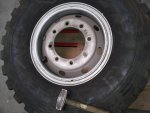
.
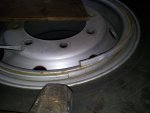
.
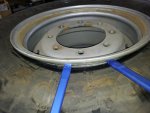
.
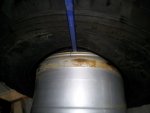
.
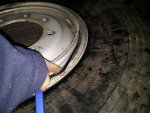
.
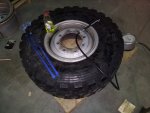
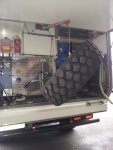
Thanks for the detailed description. I just changed 2 last weekend.
As I wanted to inverse a tube with a tubeless type.
It was my first time without help.
and it toke me some 4 hours for the 2 wheels. I dit only use te 2 smaller bars, a hammer and some Dreft.
The rim is 51kg and the tire is some 70kg. But amazing is that you can do it alone without machines.
I join some pictures to your description. It are 2 slightly different wheels with the same XZL 365/80R20 tire.
.

.

.

.

.

.


biotect
Designer
...
Hey Diplostrat,
Good to hear from you in this thread.
If you've been following it, you'll know that we've ditched the idea of a Tatra backbone tube, as well as a MAN SX-44 frame. Both are torsion-free, but too heavy. So as strongly insisted by campo and thjakits back in August, I've been getting help from some engineering friends moonlighting from Ove Arup (see http://en.wikipedia.org/wiki/Arup_Group_Limited , http://www.arup.com ), to design a an ultra-rigid titanium tubular space-frame + carbon fiber body, just as you suggested:
My friends are not automotive engineers, but if you know anything about Ove Arup, you'll know that it fosters a hyper-experimental, leading-edge, “let's try it” approach to all of its projects. Ove Arup is world-famous for finding interesting engineering solutions to difficult problems. And perhaps it's even better that my friends are not automotive engineers, because they are approaching the TerraLiner with a very "fresh", outside-the-box sort of perspective.
My personal experience with engineers has been that the very best ones absolutely love doing projects that have little to do with their ordinary, everyday more “quotidian” kinds of work.
When I was at Cambridge, for instance, I did quite a few set-designs for amateur theater productions, while simultaneously studying Philosophy, Theology, and Religious Studies. The technical directors on my set designs were almost always Cambridge graduate students who were studying engineering, who wanted to spend their time sawing plywood or painting scenery instead. One specialist in laser engineering named Dominic became a good friend, and we toured Europe together with an easily collapsible tensile-tent set that I designed for the European Theater Group – see http://etg.soc.srcf.net . One of my other sets for the ETG is the very first image posted at http://etg.soc.srcf.net/experience.php , designed for Bertold Brecht's play “The Good Person of Szechwan”:
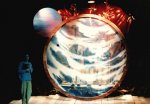
Not the best image; I will find some better ones and post them.
For that set Dominic laid 2 tons of gravel on the floor of the ADC theater, which surrounded a circular raked stage made out of rented scaff-planks. The hanging oval has scrim, which when front-lighted goes opaque, and back-lighted goes transparent – see https://www.adctheatre.com . And behind that is a huge gold-foil-covered circle as well, symbolizing the pernicious rule of money, one of the theme's of the Brecht's play.
The best part was a sheet of hanging honey-comb greenhouse plexiglass, cut again into a circular shape, and hung about half-height towards the side of the stage. Behind this honeycomb plexiglass the lead character, Shen-Te (who is an ex-prostitute), first appeared, standing on a red-painted “drawbridge” that descended from the side of the stage, again about half-height, i.e. suspended well above the floor of the stage. As the narrator describes Shen-Te, she did a bump-and-grind behind the plexiglass, and for reasons that escaped everyone, the visual effect was like Star Trek: her movements created rainbow-colored tracers that shot off in every direction. (The end of the red drawbridge was hung by big thick ropes, which gave Shen-Te the perfect vertical elements to assist here bump-and-grind.)
Of course, Dominic and his engineering friends then experimented with every possible combination of colored lights, and every possible combination of lighting angles, to maximize the Star-Trek-tracers effect, once they saw it. But this visual effect was completely unintended, and was simply a happy “spin-off” of some experimental R & D. I had always wanted to hang honeycombed plexiglass on a stage, to see what the effect might be..... ... And so the opening appearance of Shen-Te the ex-prostitute gave me the perfect excuse. The show was originally supposed to run for one week, but the ADC theater extended it to three, because there was such a demand for tickets, and the house was packed every night. Every time the actress playing the ex-prostitute did her bump-and-grind on the drawbridge-ropes behind the plexiglass, and rainbow tracers would scatter in every direction, the audience would give the visual effect a standing ovation.
... And so the opening appearance of Shen-Te the ex-prostitute gave me the perfect excuse. The show was originally supposed to run for one week, but the ADC theater extended it to three, because there was such a demand for tickets, and the house was packed every night. Every time the actress playing the ex-prostitute did her bump-and-grind on the drawbridge-ropes behind the plexiglass, and rainbow tracers would scatter in every direction, the audience would give the visual effect a standing ovation.
So yes, I have been doing curvilinear design right from the beginning. I've never wanted to do anything else…..:sombrero: ... And at Ove Arup I have a few engineering friends who, like Dominic, are keen to try their hand at something completely different: something experimental, whacky, and mobile. For free, but they'll certainly be given credit given where and when credit is due, i.e. some time mid-summer…..
Excellent thoughts about the question of heat loss: I am sort of counting on campo to crunch the numbers on my initial proposal for the quantity of TerraLiner windowing – see http://www.expeditionportal.com/for...-High-Altitude-Arctic-Antarctica-Tibet/page14 , http://www.expeditionportal.com/for...-High-Altitude-Arctic-Antarctica-Tibet/page15 . And who knows, because campo is a specialist in thermal engineering, he might come across some triple-pane windows in either the motorhome or marine market that have terrific R-values.
Also, very interesting thoughts about the overlanding format of http://www.rotel.de . And agreed, all of the overlanding companies I described above (Oasis, Dragoman, Odyssey, etc.) have a very "client-assisted, labor-intensive" business model.
All best wishes,
Biotect
Hey Diplostrat,
Good to hear from you in this thread.
If you've been following it, you'll know that we've ditched the idea of a Tatra backbone tube, as well as a MAN SX-44 frame. Both are torsion-free, but too heavy. So as strongly insisted by campo and thjakits back in August, I've been getting help from some engineering friends moonlighting from Ove Arup (see http://en.wikipedia.org/wiki/Arup_Group_Limited , http://www.arup.com ), to design a an ultra-rigid titanium tubular space-frame + carbon fiber body, just as you suggested:
Of course, as this is all a blue sky project, you could postulate the those interior partitions could be load bearing, reinforcing a honeycomb/ monocoque structure, which is exactly what I would do.
My friends are not automotive engineers, but if you know anything about Ove Arup, you'll know that it fosters a hyper-experimental, leading-edge, “let's try it” approach to all of its projects. Ove Arup is world-famous for finding interesting engineering solutions to difficult problems. And perhaps it's even better that my friends are not automotive engineers, because they are approaching the TerraLiner with a very "fresh", outside-the-box sort of perspective.
My personal experience with engineers has been that the very best ones absolutely love doing projects that have little to do with their ordinary, everyday more “quotidian” kinds of work.
When I was at Cambridge, for instance, I did quite a few set-designs for amateur theater productions, while simultaneously studying Philosophy, Theology, and Religious Studies. The technical directors on my set designs were almost always Cambridge graduate students who were studying engineering, who wanted to spend their time sawing plywood or painting scenery instead. One specialist in laser engineering named Dominic became a good friend, and we toured Europe together with an easily collapsible tensile-tent set that I designed for the European Theater Group – see http://etg.soc.srcf.net . One of my other sets for the ETG is the very first image posted at http://etg.soc.srcf.net/experience.php , designed for Bertold Brecht's play “The Good Person of Szechwan”:

Not the best image; I will find some better ones and post them.
For that set Dominic laid 2 tons of gravel on the floor of the ADC theater, which surrounded a circular raked stage made out of rented scaff-planks. The hanging oval has scrim, which when front-lighted goes opaque, and back-lighted goes transparent – see https://www.adctheatre.com . And behind that is a huge gold-foil-covered circle as well, symbolizing the pernicious rule of money, one of the theme's of the Brecht's play.
The best part was a sheet of hanging honey-comb greenhouse plexiglass, cut again into a circular shape, and hung about half-height towards the side of the stage. Behind this honeycomb plexiglass the lead character, Shen-Te (who is an ex-prostitute), first appeared, standing on a red-painted “drawbridge” that descended from the side of the stage, again about half-height, i.e. suspended well above the floor of the stage. As the narrator describes Shen-Te, she did a bump-and-grind behind the plexiglass, and for reasons that escaped everyone, the visual effect was like Star Trek: her movements created rainbow-colored tracers that shot off in every direction. (The end of the red drawbridge was hung by big thick ropes, which gave Shen-Te the perfect vertical elements to assist here bump-and-grind.)
Of course, Dominic and his engineering friends then experimented with every possible combination of colored lights, and every possible combination of lighting angles, to maximize the Star-Trek-tracers effect, once they saw it. But this visual effect was completely unintended, and was simply a happy “spin-off” of some experimental R & D. I had always wanted to hang honeycombed plexiglass on a stage, to see what the effect might be.....
So yes, I have been doing curvilinear design right from the beginning. I've never wanted to do anything else…..:sombrero: ... And at Ove Arup I have a few engineering friends who, like Dominic, are keen to try their hand at something completely different: something experimental, whacky, and mobile. For free, but they'll certainly be given credit given where and when credit is due, i.e. some time mid-summer…..
Excellent thoughts about the question of heat loss: I am sort of counting on campo to crunch the numbers on my initial proposal for the quantity of TerraLiner windowing – see http://www.expeditionportal.com/for...-High-Altitude-Arctic-Antarctica-Tibet/page14 , http://www.expeditionportal.com/for...-High-Altitude-Arctic-Antarctica-Tibet/page15 . And who knows, because campo is a specialist in thermal engineering, he might come across some triple-pane windows in either the motorhome or marine market that have terrific R-values.
Also, very interesting thoughts about the overlanding format of http://www.rotel.de . And agreed, all of the overlanding companies I described above (Oasis, Dragoman, Odyssey, etc.) have a very "client-assisted, labor-intensive" business model.
All best wishes,
Biotect
Last edited:
nick disjunkt
Adventurer
It's a small world, I also work for Arup.
biotect
Designer
Hi Nick,
Can't tell you the names of my friends, otherwise I sort of "blow" my cover. And it's important to me (and to them) to remain a bit anonymous until the final finished project is unveiled.
But yes, it's a small world, isn't it. Ove Arup now has over 11,000 employees; do you work in the London office? Australia? The United States? But if you want to keep that under wraps too, no worries. Most people on these forums like to maintain a "semi-anonymous" status, gradually revealing bits and pieces about themselves. I know who a number of contributors to this thread actually are, in person, but the focus in this forum is really on technology and the vehicles, not personalities. Lots of engineers, and relatively few "political" types.
Have you ever participated in the on-line forums provided by The Economist? Exactly the opposite: hyper-political, often very nasty, and The Economist forums have to be constantly moderated, and posts constantly deleted, because participants get so out of control. Anti-Americans will deliberately post blistering insults against the United States in the "comments" section of articles written under the "Lexington" column; while anti-EU or anti-European types will post equally blistering insults in the "comments" section of articles written under the "Charlemagne" column. In other words, they post under these columns precisely in order to piss off either (a) Americans, of the kind who read "Lexington", or (b) Europeans, of the kind who read "Charlemagne". Indeed, seems like at least half of those posting under "Charlemagne" are little-Englanders who vote for or work for UKIP. Which is just plain weird, because "Charlemagne" is a column all about European affairs, generally written from a relatively pro-EU point of view -- see http://www.economist.com/blogs/charlemagne .
Because I am still somewhat interested in sociology, economics, and politics, and have a bit of background in the same, I read The Economist regularly, and for a few wasted months participated in its discussion blogs. But ExPo is much preferred, because the things discussed here are so much closer to my heart. And the discussion on ExPo always remains civil, and always focused on overlanding and vehicles.....
All best wishes,
Biotect
Can't tell you the names of my friends, otherwise I sort of "blow" my cover. And it's important to me (and to them) to remain a bit anonymous until the final finished project is unveiled.
But yes, it's a small world, isn't it. Ove Arup now has over 11,000 employees; do you work in the London office? Australia? The United States? But if you want to keep that under wraps too, no worries. Most people on these forums like to maintain a "semi-anonymous" status, gradually revealing bits and pieces about themselves. I know who a number of contributors to this thread actually are, in person, but the focus in this forum is really on technology and the vehicles, not personalities. Lots of engineers, and relatively few "political" types.
Have you ever participated in the on-line forums provided by The Economist? Exactly the opposite: hyper-political, often very nasty, and The Economist forums have to be constantly moderated, and posts constantly deleted, because participants get so out of control. Anti-Americans will deliberately post blistering insults against the United States in the "comments" section of articles written under the "Lexington" column; while anti-EU or anti-European types will post equally blistering insults in the "comments" section of articles written under the "Charlemagne" column. In other words, they post under these columns precisely in order to piss off either (a) Americans, of the kind who read "Lexington", or (b) Europeans, of the kind who read "Charlemagne". Indeed, seems like at least half of those posting under "Charlemagne" are little-Englanders who vote for or work for UKIP. Which is just plain weird, because "Charlemagne" is a column all about European affairs, generally written from a relatively pro-EU point of view -- see http://www.economist.com/blogs/charlemagne .
Because I am still somewhat interested in sociology, economics, and politics, and have a bit of background in the same, I read The Economist regularly, and for a few wasted months participated in its discussion blogs. But ExPo is much preferred, because the things discussed here are so much closer to my heart. And the discussion on ExPo always remains civil, and always focused on overlanding and vehicles.....
All best wishes,
Biotect
Last edited:
biotect
Designer
..
Hi dwh,
As always, excellent, informative post.
The "fish in a bowl" or "privacy" aspect of things can be easily dealt with by the various solutions already implemented in large American Class-A and German "Liner" Motorhomes. For an extended review of some of the options, see the Camper Thermal Engineering thread, posts #106 to #112, at http://www.expeditionportal.com/for...-High-Altitude-Arctic-Antarctica-Tibet/page11 and http://www.expeditionportal.com/for...-High-Altitude-Arctic-Antarctica-Tibet/page12 . Some combination of roller-thermal-shades and/or smart glass should do the trick. And should also take care of the greenhouse/sweatbox/icebox problem.
If you feel inclined, please post the in the Camper Thermal Engineering thread as well; it would be great to have your feedback there, too, especially as regards the question of insulating thermal shades for large windows.
But there still remains the security problem, and your "Lexan shutter solution" sounds very interesting. As you suggest, the end result would be a quadruple-pane window, with the outermost layer hammer-proof. Short of specifying heavy bullet-proof glass for all windows, your "Lexan shutter" solution seems like a good compromise.
All best wishes,
Biotect
In an overland bus, you have people in the rear cabin while the vehicle is underway. So in the bus, they *must* have those windows - not unlike a passenger car in a train.
But that's a compromise.
Drawbacks to the large glass area:
* It can get damaged.
* Not great insulation.
* Can turn the living space into a greenhouse/sweatbox/icebox, which then increases heating and cooling system requirements.
* Can turn the occupants into, as Haf-E just said, "fish in a bowl".
* Security vulnerability.
For a bus, you have to compromise and accept the drawbacks. Not so for a campervan.
In an overland campervan designed to accommodate a couple on a long term journey, both people will probably be in the front while underway (most of the time anyway).
All that glass might be nice to have when parked (though large screened hatches might be even nicer - especially parked on a beach), they aren't needed while underway and are certainly a security issue while shipping (and your truck will be too big to fit in a container).
In real world use, I would suspect that most people would simply leave the <campervan with large glass area> "buttoned up" and let the climate control keep it at a comfortable temperature. They would have to, because with a large glass area, the internal temperature is going to fairly rapidly equalize with the external temperature if they don't.
Don't recall if I've mentioned it in this thread, but one idea I had was to make "storm shutters" out of Lexan. Take say two 1/4" pieces and bolt them together with a 1/4" o-ring sandwiched around the interior circumference to create an air space. Attach the assembled sandwich with top hinges and use bottom latches to keep them secure, and cranks to open them.
Essentially, a casement window, with the hinge at the top instead of the side, and double pane-glass (well, plastic) sandwich:

The idea is to have normal sort of "RV style" double-pane, sliding windows with screens mounted toward the inside of a thick campervan wall, then have the storm shutter mounted toward the outside (both embedded flush of course).
When closed, they provide security. Thick Lexan makes a very decent "bulletproof glass", and even thin Lexan is pretty tough. 1/4" (or thicker) wouldn't be all that easy to break even with a hammer. And scratches can be buffed out.
When closed, they provide a second layer of double-pane glass for insulation. I.e., 4 layers (two of glass, two of Lexan) with 3 air spaces in the sandwich.
They can be "cracked open" or opened only a bit to provide ventilation.
They can be opened partially or fully - either way providing an awning over the window.
Probably a good idea to tint them with something like limo tint.
Make the bottom sill of the storm shutter sloped to the outside, with drain holes, and you can leave them closed, but leave the internal windows cracked open, and condensation is going to end up running down the outside of the cabin.
Sign graphics, or vehicle wraps, can be had in "perforated see-through", so the storm shutters could also be covered with that material and made to blend in with the vehicle's paint/graphics, and from a distance, probably wouldn't even look like windows.
Hi dwh,
As always, excellent, informative post.
The "fish in a bowl" or "privacy" aspect of things can be easily dealt with by the various solutions already implemented in large American Class-A and German "Liner" Motorhomes. For an extended review of some of the options, see the Camper Thermal Engineering thread, posts #106 to #112, at http://www.expeditionportal.com/for...-High-Altitude-Arctic-Antarctica-Tibet/page11 and http://www.expeditionportal.com/for...-High-Altitude-Arctic-Antarctica-Tibet/page12 . Some combination of roller-thermal-shades and/or smart glass should do the trick. And should also take care of the greenhouse/sweatbox/icebox problem.
If you feel inclined, please post the in the Camper Thermal Engineering thread as well; it would be great to have your feedback there, too, especially as regards the question of insulating thermal shades for large windows.
But there still remains the security problem, and your "Lexan shutter solution" sounds very interesting. As you suggest, the end result would be a quadruple-pane window, with the outermost layer hammer-proof. Short of specifying heavy bullet-proof glass for all windows, your "Lexan shutter" solution seems like a good compromise.
All best wishes,
Biotect
nick disjunkt
Adventurer
I work in the London office, Arup's London ATG group are particularly good with the kind of project that you are doing.

